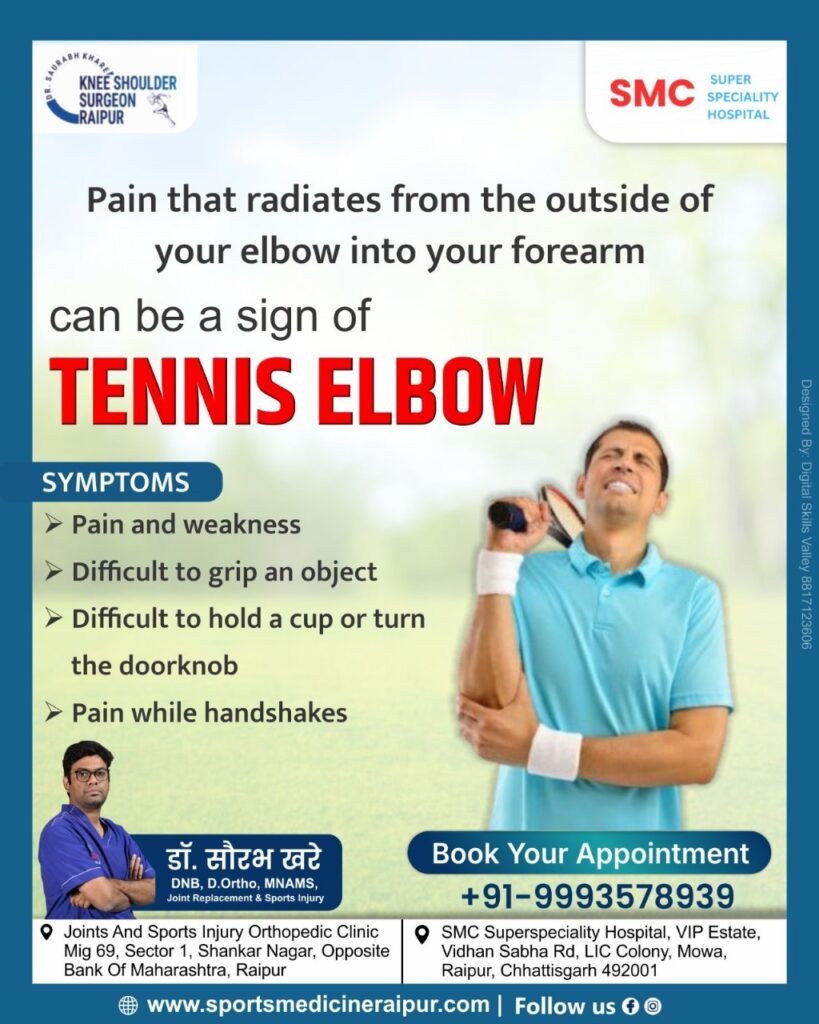Introduction
Tennis elbow, also known as lateral epicondylitis, is a common condition that causes pain around the outside of the elbow. Despite its name, tennis elbow can affect anyone who overuses the muscles of the forearm, not just tennis players. This overuse leads to inflammation and small tears in the tendons that attach the forearm muscles to the outside of the elbow, causing pain and discomfort.
Symptoms of Tennis Elbow
Recognizing the symptoms of tennis elbow is the first step towards getting appropriate treatment. The most common symptoms include:
- Pain and Weakness: This pain often starts on the outside of the elbow and can radiate into the forearm and wrist. You might notice a gradual increase in pain, and it can range from a mild ache to a sharp, burning sensation.
- Difficulty Gripping Objects: Holding a racquet, turning a wrench, or even shaking hands can become painful and challenging. This is due to the inflammation in the tendons, which are crucial for gripping.
- Pain While Lifting or Bending the Arm: Simple actions like lifting a cup or turning a doorknob can become difficult and painful.
- Pain During Handshakes: Even a firm handshake can cause discomfort, as the action puts pressure on the tendons.
Causes of Tennis Elbow
Tennis elbow is primarily caused by overuse and repetitive motion. Some common activities that can lead to tennis elbow include:
- Racket Sports: Tennis, badminton, and squash require repetitive arm and wrist movements that can strain the tendons.
- Occupational Hazards: Jobs that involve repetitive motions of the arm and wrist, such as painting, typing, or using tools, can contribute to the development of tennis elbow.
- Repetitive Activities: Activities like gardening, knitting, or playing certain musical instruments can also cause strain on the forearm muscles and tendons.
Diagnosing Tennis Elbow
To diagnose tennis elbow, a doctor will typically:
- Review Medical History: Understanding the patient’s activities and any history of injury.
- Physical Examination: The doctor may press on the affected area or ask the patient to move their arm, wrist, and fingers in various ways to check for pain and weakness.
- Imaging Tests: X-rays or MRI scans might be used to rule out other conditions such as arthritis or a fracture.
Treatment Options
Treatment for tennis elbow often involves a combination of rest, physical therapy, and medications. Here are some common treatment methods:
- Rest and Activity Modification: Avoiding activities that cause pain and giving the arm adequate rest is crucial. Modifying activities to reduce strain on the elbow can help prevent further damage.
- Ice and Heat Therapy: Applying ice packs to the affected area can help reduce inflammation and pain. Heat packs can be used to relax and loosen the muscles and tendons.
- Physical Therapy: Exercises to stretch and strengthen the forearm muscles and tendons can help. A physical therapist can guide patients through specific exercises tailored to their needs.
- Medications: Nonsteroidal anti-inflammatory drugs (NSAIDs) like ibuprofen can help reduce pain and inflammation.
- Braces and Supports: Using a brace or strap around the forearm can help reduce strain on the affected tendons.
- Steroid Injections: In some cases, corticosteroid injections may be recommended to reduce inflammation.
- Extracorporeal Shock Wave Therapy (ESWT): This non-invasive treatment uses shock waves to stimulate healing in the affected tendons.
- Surgery: If conservative treatments fail, surgery might be considered. The procedure usually involves removing damaged tissue and reattaching healthy tissue to the bone.
Preventing Tennis Elbow
Preventing tennis elbow involves taking steps to reduce strain on the forearm muscles and tendons:
- Proper Technique: Ensuring correct technique in sports and activities can help reduce strain. Seeking advice from a coach or trainer might be beneficial.
- Strengthening Exercises: Regular exercises to strengthen the forearm muscles can help. This includes wrist curls, reverse wrist curls, and grip strengthening exercises.
- Ergonomic Adjustments: Making adjustments at work, such as ensuring proper posture and using ergonomic tools, can help prevent strain.
- Taking Breaks: Taking regular breaks during repetitive activities can help reduce the risk of overuse.
Why Choose Dr. Saurabh Khare?
Dr. Saurabh Khare, a renowned orthopaedic surgeon in Raipur, specializes in joint replacement and sports injuries. With a dedicated clinic for joint and sports injuries, Dr. Saurabh Khare provides comprehensive care for patients suffering from tennis elbow and other musculoskeletal conditions. His expertise in diagnosing and treating tennis elbow ensures that patients receive the highest standard of care, from initial assessment to rehabilitation.
Conclusion
Tennis elbow is a common condition that can cause significant pain and discomfort. Recognizing the symptoms early and seeking appropriate treatment can help manage the condition effectively. By following preventive measures and consulting with an experienced specialist like Dr. Saurabh Khare, individuals can reduce their risk of developing tennis elbow and enjoy a pain-free life.
Contact Information
Website: https://sportsmedicineraipur.com/
Phone Number: 9993578939
Clinic: Joints And Sports Injury Orthopedic Clinic, Mig 69, Sector 1, Shankar Nagar, Opposite Bank Of Maharashtra, Raipur.
Hospital: SMC Superspeciality Hospital, VIP Estate, Vidhan Sabha Rd, LIC Colony, Mowa, Raipur, Chhattisgarh 492001.
By understanding the causes, symptoms, and treatment options for tennis elbow, individuals can take proactive steps to manage and prevent this condition, ensuring a healthier and more active lifestyle.

